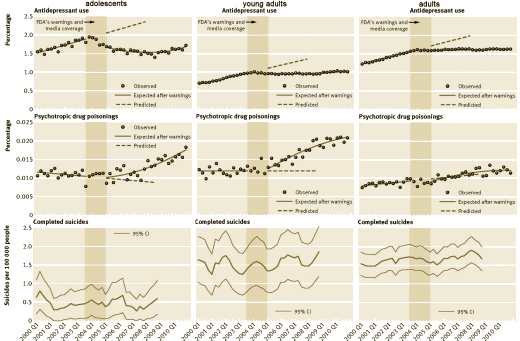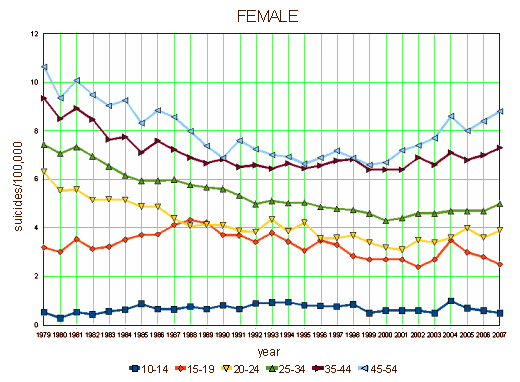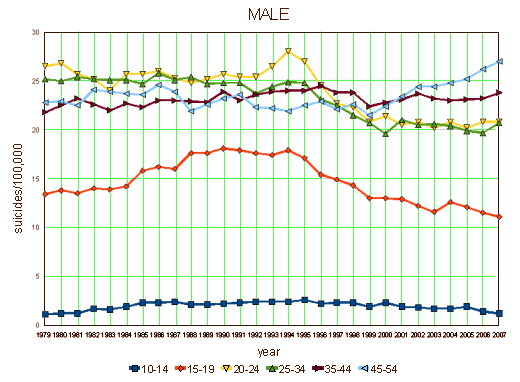by Christine Y Lu, Fang Zhang, Matthew D Lakoma, Jeanne M Madden, Donna Rusinak, Robert B Penfold, Gregory Simon, Brian K Ahmedani, Gregory Clarke, Enid M Hunkeler, Beth Waitzfelder, Ashli Owen-Smith, Marsha A Raebel, Rebecca Rossom, Karen J Coleman, Laurel A Copeland, and Stephen B SoumeraiBritish Medical Journal. 2014 348:g3596.
Objective To investigate if the widely publicized warnings in 2003 from the US Food and Drug Administration about a possible increased risk of suicidality with antidepressant use in young people were associated with changes in antidepressant use, suicide attempts, and completed suicides among young people.Design Quasi-experimental study assessing changes in outcomes after the warnings, controlling for pre-existing trends.Setting Automated healthcare claims data [2000-10] derived from the virtual data warehouse of 11 health plans in the US Mental Health Research Network.Participants Study cohorts included adolescents [around 1.1 million], young adults [around 1.4 million], and adults [around 5 million].Main outcome measures Rates of antidepressant dispensings, psychotropic drug poisonings [a validated proxy for suicide attempts], and completed suicides.Results Trends in antidepressant use and poisonings changed abruptly after the warnings. In the second year after the warnings, relative changes in antidepressant use were −31.0% [95% confidence interval −33.0% to −29.0%] among adolescents, −24.3% [−25.4% to −23.2%] among young adults, and −14.5% [−16.0% to −12.9%] among adults. These reflected absolute reductions of 696, 1216, and 1621 dispensings per 100 000 people among adolescents, young adults, and adults, respectively. Simultaneously, there were significant, relative increases in psychotropic drug poisonings in adolescents [21.7%, 95% confidence interval 4.9% to 38.5%] and young adults [33.7%, 26.9% to 40.4%] but not among adults [5.2%, −6.5% to 16.9%]. These reflected absolute increases of 2 and 4 poisonings per 100 000 people among adolescents and young adults, respectively [approximately 77 additional poisonings in our cohort of 2.5 million young people]. Completed suicides did not change for any age group.Conclusions Safety warnings about antidepressants and widespread media coverage decreased antidepressant use, and there were simultaneous increases in suicide attempts among young people. It is essential to monitor and reduce possible unintended consequences of FDA warnings and media reporting.

I sippose that I would be predicted to react negatively to this article, described by some today as the most famous article on the planet several hours after it went online. But to be honest, I spent the afternoon reading and rereading the Methods section to no avail. It actually reminded me of those opaque Gibbons articles [an anatomy of a deceit 1… etc] two years ago. Even if it said what I would expect it to say, I wouldn’t believe it either without a major methodological explanation. For one thing, the suicide data from these HMOs is radically different in shape and magnitude from that in the CDC Compressed Mortality which goes back to 1979 [see peaks and valleys…]:


Whatever the case, I expect there will be re-analyses all over the Internet by month’s end. So if you’re going to read this article, read the Methods section first and if you understand what they actually did, please enlighten the rest of us…
But we as psychiatrists knew this was coming. Again, the extremists from BOTH sides of the polarized aisle wanted it black and white, right or wrong, good or bad. Sometimes treatments can hurt people, but, sometimes not getting treated can hurt people too.
But, there are agendas to be maintained, and causes to be won. The public be damned. Psychiatrists want cash and influence, detractors (better word for those who dislike psychiatry?) want clinicians bound and gagged.
And the public is left to fend for themselves. Wow, there is a winner, eh? Just like the empty debate going on about Iraq now.
IF their methodology is correct, I wonder how many of those teens went into withdrawals after 2004 due to GPs not willing to renew their prescriptions. Additionally, how would results had looked had they plotted total psych drug usage (instead of antidepressants) with time? I’m pretty sure total psych drug usage has increased in teens mainly from ADHD drugs…
I am willing to cut them some slack on the description of their methods. But there are still some squirrelly aspects to this report. For starters, they equivocated about whether described differences are statistically significant. They used the term ‘significant’ a lot but they used the term ‘statistically significant’ only once. That was in relation to psychotropic drug poisoning among adolescent males. The data for adolescent males look like outliers (Table 2). The lack of an effect for adolescent females does not comport with the well-known preponderance of adolescent females among suicide attempters. Moreover, even the single claim of statistical significance was assigned no p value and was uncorrected for multiple comparisons.
Second, they focused just on the second year after the black box warning period but they did not examine trends following the warning in the same way as they projected trends from before the warnings. So, when we take a hard look at Figure 1, the rate of suicide attempts among adolescents didn’t change for 11 quarters after the end of the black box period. The suicide attempt rate didn’t start to rise until the rate of antidepressant drug prescribing started to rebound. Go figure.
Third, among the young adults (Figure 2) there was no change in antidepressant drug prescribing – just a flat trajectory. Plus, there was no change in sample size, so the rise in psychotropic drug poisonings was unrelated to change in antidepressant drug use – absolute or per capita. Something else was going on. Meth, anybody? Oxycodone, anybody? These authors don’t have a clue. This points up how inadequate is their proxy measure of suicide attempts.
Fourth, there was no change in the hard outcome of completed suicide. The authors tried to finesse this finding with the statement that completed suicide is a rare event. Well, it’s not that rare, especially when you trumpet that you have a sample size in the millions.
I won’t even bother to critique the special pleading and the tendentious tone of this report, and I agree with Dr. Mickey that the decision to publish it was not the BMJ’s finest hour.
Not a statistician but this blog has some comments on Interrupted Time Series Design
http://www.csulb.edu/~msaintg/ppa696/696quasi.htm
Susanna,
Thanks!
BIWX
Dr Carroll makes the following criticism of the study in question:
Fourth, there was no change in the hard outcome of completed suicide
But if he were to look at the US population suicide numbers or rates by age and gender across the time period from say 1985 (before fluoxetine introduced) and up till the present and focusing in particular as new antidepressants are introduced or gain pediatric and adolescent indication, there is non concomitant increase in suicide deaths (the CDC frowns on the phrase “completed suicide”) in those same age groups. But by Dr Carroll logic, no increase in suicide deaths when SSRI use dropped needs to be viewed against there being NO increase in suicide deaths in the same groups when the antidepressants were introduced and use increased. There is not a direct, linear relationship between suicide related behaviors (ideation, attempts and self injurious behaviors) and suicide death, one is not a surrogate measure for the other. This is revealed in the data set the FDA utilized to issue the initial pediatric and adolescent warning, in which there were no suicide deaths.
To Dr. Garlow’s point: First, Lu and co-authors were the ones who stipulated completed suicide as a primary end point, and had they found a significant effect we can be sure they would have highlighted it.
Second, Lu et al did not examine the same variable as the FDA did. Lu et al did not consider “suicide related behaviors (ideation, attempts and self injurious behaviors)…” (Dr. Garlow). They considered only medical claims related to clinical encounters for psychotropic drug poisoning, which they treated as a proxy for suicide attempts.
Had those encounters been genuine suicide attempts then we would expect to see completed suicides result at a rate of about 8% (see PubMed ID#11111261). With 77 extra encounters reported in Year 2, that would result in 6 additional suicide deaths, which is roughly a 25% increase over the pooled base rate of about 4 per 100,000 per year in the “2.5 million young people” (adolescents plus young adults). The absence of such a spike thus calls into question the validity of the surrogate end point. Lu et al. have no way of knowing how many of these encounters were related to the epidemic of non-suicidal drug misuse among young people (methedrine, opiates, stimulants).
Dr. Garlow’s comment does usefully remind us that aggregated population figures are often unhelpful for understanding processes. In the case of antidepressants and suicide, my analysis following publication of the 2004 TADS report in JAMA pointed to 2 offsetting effects in the treated population of adolescents – prevention of depression-related suicides on the one hand and induction of drug-related suicides on the other hand. These two effects resulted in equipoise as to the aggregate number of observed suicides (see PubMed ID#15572711).
Oops… I checked my math… the expected increase of suicides based on 77 extra encounters would represent a 6% increase, not a 25% increase. Sorry about that.
I cannot see how events reported as drug poisonings have any relationship at all to completed suicides. A lot of drug poisonings are unintentional drug-drug interactions.
From Dr. Mickey’s graphs, I do not see the rise in youth suicides correlated to a decrease in antidepressant prescribing found by this “quasi-experiment.”
It’s one thing to confuse correlation with causation, calling a non-correlation a causation is nothing but wishful thinking!
I mean — Dr. Mickey’s graphs do not show a rise in youth suicides!